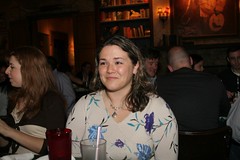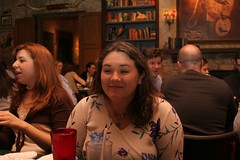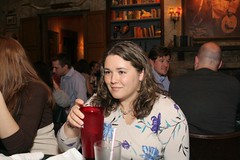Tripods can help one take better photographs. Many photographs, especially at longer focal lengths, suffer varying amounts from the blur of camera shake. The disadvantages of tripods are that they are bulky and heavy and inconvenient. Some camera bodies and lenses have built-in image stabilization, but they are often expensive.
I spent a few weeks shopping for tripods, and these are the notes I kept.
I had a cheap tripod until my DSLR broke the head so that it could no longer be used. It's worthwhile to buy a better tripod because it can last a long time, and it holds its value. Some photographers point to Thom Hogan's article. His recommendations are still expensive at $600 though.
After reading forum posts, I decided to go with the Bogen 3021BPro for $150 from binoculars.com (after google checkout discount). The 3021 series is recommended as a sturdy though heavy (~5.3 lbs) tripod. The B series are black, and the Pro series costs $10 more and weighs a few more ounces, but it allows a horizontal positioning of the center column, which can be useful for macro photography over a flower, for instance.
I also considered a Bogen 3001BD. The B is again black, the D model costs more than the N models because they have flip levers on the legs instead of twist locks. The 3001 series is lighter than the 3021 series, but they are much shorter: 47" high without a center column, and 57" with the center column extended. The 3021 is 53" and 70" with center column.
Other options: Feisol is a Taiwanese company that makes affordable carbon fiber tripods, and they are mainly sold direct from the manufacturer. The Slik 700DX is a more affordable option, but it's a little less flexible and it only comes in silver.
For a head, I bought a used Bogen 488RC2 ball head for $80. The ball heads are much more flexible because you have one knob to release the ball to move any direction. Also, ball heads are more compact than the pan and scan (3D) models, which have three levers sticking out. The 488 costs a bit more than the 486, but it is sturdier and it has a panning base. The 486 is the cheapest current ball head available from Bogen.
Monday, December 25, 2006
Wednesday, November 08, 2006
colorspace workflow
Chris Dodkin posted a basic colorspace workflow on the FM Forums:
1) Set color space on your camera - choose a full gamut color space such as Adobe RGB - shoot RAW to avoid your camera making the color temp decisions for you
2) Calibrate your computer monitor - start HERE
3) Set default color space in Photoshop to match the camera, so Adobe RGB in this case
4) Import RAW file into photoshop, making decision on color temp etc
5) Edit image and store as PSD file to avoid any image compression or data loss
6) Assign image the color space profile from your chosen printer (downloaded from Drycreek)
7) You can compare the new image against the stored Adobe RGB version, either by flicking backwards and forwards in PS, or comparing it with a previous copy.
You'll see the color of the image with the printer color profile assigned has changed.
8) Use curves and other color balance tools in PS to modify the new file to get back to the color of the original Adobe RGB file
9) Save the modified file as a lossless TIFF with no color profile embedded
10) Take the TIFF to the lab - upload and tell the staff 'PRINT WITH NO CORRECTIONS ON THE CALIBRATED PRINTER'
11) Collect your print and marvel at how it looks just like the image on your computer screen
Far more detail @ DRYCREEK
1) Set color space on your camera - choose a full gamut color space such as Adobe RGB - shoot RAW to avoid your camera making the color temp decisions for you
2) Calibrate your computer monitor - start HERE
3) Set default color space in Photoshop to match the camera, so Adobe RGB in this case
4) Import RAW file into photoshop, making decision on color temp etc
5) Edit image and store as PSD file to avoid any image compression or data loss
6) Assign image the color space profile from your chosen printer (downloaded from Drycreek)
7) You can compare the new image against the stored Adobe RGB version, either by flicking backwards and forwards in PS, or comparing it with a previous copy.
You'll see the color of the image with the printer color profile assigned has changed.
8) Use curves and other color balance tools in PS to modify the new file to get back to the color of the original Adobe RGB file
9) Save the modified file as a lossless TIFF with no color profile embedded
10) Take the TIFF to the lab - upload and tell the staff 'PRINT WITH NO CORRECTIONS ON THE CALIBRATED PRINTER'
11) Collect your print and marvel at how it looks just like the image on your computer screen
Far more detail @ DRYCREEK
Monday, May 22, 2006
2006 Chicago Summerdance Schedule
I do enjoy the summers of Chicago. Every season has its charm, and summer has her way of enticing me outdoors. I spend more than enough time indoors, and it's, well, a breath of fresh air to get out. As much as possible in an industrialized urban metropolis, of course.
One of the highlights of summer for me has been summerdance. For ten weekends from June to August, dances are held at a 3,500 square foot open-air dance floor. They feature an hour-long lesson, followed by two hours of live music. The dances span genres, from swing to salsa to ballroom. And it's all free.
Earlier on Google, I had found only links to
http://www.cityofchicago.org/CulturalAffairs/SummerDance/
which automatically redirected to a link that starts
http://egov.cityofchicago.org/city/webportal/ [... session blah blah...]
which then had a link to
http://877chicago.com
which I searched using keyword summerdance, and that brought me to the calendar
http://www.choosechicago.com/new_site/coe.cfm
which helpfully suggested the link
http://www.cityofchicago.org/CulturalAffairs/SummerDance/
hmm. Hey Look! Big Ben! (National Lampoon reference).
If it's not on Google, it can't possibly exist online. Yet last week, a swing dancing friend told me that she'd found the schedule online as a PDF. Could it be? Is Google losing its touch? I checked live.com and [Chicago Tribune] metromix. No hits.
Believing my friend not to be entirely evil, I persevered. I searched the city of Chicago website for "Lesley Byers" a friend whom I knew would be performing. It brought me to a page with a number of images on the left side. The fifth image down was a link to the PDF schedule. Sweet victory!
Chicago Summerdance Calendar Schedule
[update: their link had a session ID and gave a nice null pointer exception when I tried to save the link, so I'm hosting the schedule locally.]
[update 6/2: The schedule is also online as text now, but you have to go through their main site, then get redirected, then choose to view by date (month) or by music genre.]
Verse of the day:
One of the highlights of summer for me has been summerdance. For ten weekends from June to August, dances are held at a 3,500 square foot open-air dance floor. They feature an hour-long lesson, followed by two hours of live music. The dances span genres, from swing to salsa to ballroom. And it's all free.
Earlier on Google, I had found only links to
http://www.cityofchicago.org/CulturalAffairs/SummerDance/
which automatically redirected to a link that starts
http://egov.cityofchicago.org/city/webportal/ [... session blah blah...]
which then had a link to
http://877chicago.com
which I searched using keyword summerdance, and that brought me to the calendar
http://www.choosechicago.com/new_site/coe.cfm
which helpfully suggested the link
http://www.cityofchicago.org/CulturalAffairs/SummerDance/
hmm. Hey Look! Big Ben! (National Lampoon reference).
If it's not on Google, it can't possibly exist online. Yet last week, a swing dancing friend told me that she'd found the schedule online as a PDF. Could it be? Is Google losing its touch? I checked live.com and [Chicago Tribune] metromix. No hits.
Believing my friend not to be entirely evil, I persevered. I searched the city of Chicago website for "Lesley Byers" a friend whom I knew would be performing. It brought me to a page with a number of images on the left side. The fifth image down was a link to the PDF schedule. Sweet victory!
Chicago Summerdance Calendar Schedule
[update: their link had a session ID and gave a nice null pointer exception when I tried to save the link, so I'm hosting the schedule locally.]
[update 6/2: The schedule is also online as text now, but you have to go through their main site, then get redirected, then choose to view by date (month) or by music genre.]
Verse of the day:
No one lights a lamp and hides it in a jar or puts it under a bed. Instead, he puts it on a stand, so that those who come in can see the light. For there is nothing hidden that will not be disclosed, and nothing concealed that will not be known or brought out into the open.- Luke 8:16-17
Friday, May 12, 2006
Comparison of bounced flash
A comparison of three ways of using an external flash mounted on-camera. That's Emma in the photographs.
Direct flash:
Flash pointed directly at subject.

Bounced flash: I actually like this the best, as I feel it is the most natural looking. However, the ceiling was high, so the flash ran out of power, leaving the bottom half of the photo underexposed.
Diffused bounced flash:
Flash was pointed straight at a high ceiling. The difference from the earlier photograph is that I added a small bubble wrap bag over my flash, such that it stuck out a few inches above like a little hat. I'm still playing with different flash modifiers. I don't like the coldness of the color balance, but the background is a little brighter due to the spread light of the flash and the lighting is softer on the subject.

Direct flash:
Flash pointed directly at subject.

Bounced flash: I actually like this the best, as I feel it is the most natural looking. However, the ceiling was high, so the flash ran out of power, leaving the bottom half of the photo underexposed.

Diffused bounced flash:
Flash was pointed straight at a high ceiling. The difference from the earlier photograph is that I added a small bubble wrap bag over my flash, such that it stuck out a few inches above like a little hat. I'm still playing with different flash modifiers. I don't like the coldness of the color balance, but the background is a little brighter due to the spread light of the flash and the lighting is softer on the subject.

Tuesday, May 09, 2006
chimping
Chimping is a byproduct of digital photography. It is the act of looking at the LCD of a digital camera after taking a picture. One rumor is that it started in the world of sports photography. After a big play, all the photographers could be seen viewing the LCD screens of their cameras. They might have even compared shots with one another. It is often accompanied by noises such as grunting or "ooo" or "aah", which may account for its name.
There is a wiki article already, and an amusing video on sports shooter.
Some professional photographers scoff at chimping. They claim it marks one as an amateur, as it interrupts the flow of the action and may cause one to miss shots. As much I may desire to look professional, I will not give up chimping, because I know it helps me. I still check histograms, show off, and--even occasionally--make the sounds. Well, maybe I can give up the sounds.
There is a wiki article already, and an amusing video on sports shooter.
Some professional photographers scoff at chimping. They claim it marks one as an amateur, as it interrupts the flow of the action and may cause one to miss shots. As much I may desire to look professional, I will not give up chimping, because I know it helps me. I still check histograms, show off, and--even occasionally--make the sounds. Well, maybe I can give up the sounds.
Subscribe to:
Posts (Atom)

